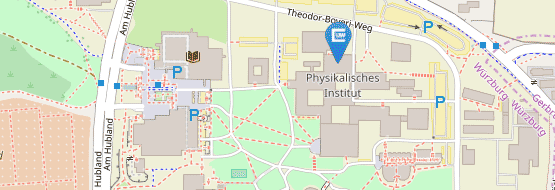Würzburg ToCoTronics Colloquium
"Imaging the itinerant-to-localized transmutation of electrons across the metal-to-insulator transition in Vanadium(III)-oxide"
| Datum: | 20.11.2025, 16:15 - 18:00 Uhr |
| Kategorie: | Kolloquium |
| Ort: | Hubland Süd, Geb. P1 (Physik), HSP P (Röntgen HS) |
| Veranstalter: | SFB 1170 ToCoTronics |
| Vortragende: | Prof. Andres Santander-Syro - Université Paris-Saclay |
According to the “Standard Model” of Condensed-Matter Physics, namely the Bloch theory, metal or insulator are mutually exclusive states of matter. In insulators the highest occupied quantum-mechanical energy band is totally filled with electrons, while in metals it is partially filled. Thus, as temperature cannot change the number of electrons in a solid, it should not change either its intrinsic nature, i.e. metallic or insulating. However, V2O3, a metal at room temperature, shows a first-order metal-to-insulator transition (MIT) when cooling below TMIT≈160 K with an abrupt resistivity change of over six orders of magnitude. The very existence of a metal-to-insulator transition shakes the foundations of the well-tested Bloch model!
In fact in V2O3, as in many other transition-metal oxides, the last partially filled band is formed out of d-orbitals, which are rather localized in space. Thus, electrons in these bands can hardly avoid each other, and are subject to their strong mutual repulsion –the electron correlations, neglected in Bloch theory. The strong repulsion between electrons can inhibit their movement and result in a “Mott” metal-to-insulator transition (MIT), a fundamental phenomenon whose understanding has remained a challenge for over 50 years. A key issue is how the wave-like itinerant electrons in the metallic state change into a localized-like state in the insulator due to increased interactions. However, observing the MIT in terms of the energy- and momentum-resolved electronic structure of the system, the only direct way to probe both itinerant and localized states, has been elusive.
In this talk, I will discuss our recent experimental studies of the MIT in V2O3 [1] using angle-resolved photoemission spectroscopy. We found that in this material the temperature-induced MIT is characterized by the progressive disappearance of the conduction band of itinerant electrons, without any change in its energy-momentum dispersion, and the simultaneous shift to larger binding energies of a quasi-localized state initially located near the Fermi level. Only when the state of itinerant electrons crossing the Fermi level has vanished, a complete gap of about 700 meV is observed, associated to the final energy position of the quasi-localized state. Furthermore, the spectral weights of the itinerant and quasi-localized states show a clear thermal hysteresis that tracks the one observed in resistivity data across the MIT.
[1] M. Thees et al., Science Advances 7, eabj1164 (2021).
Key words: Correlated electron systems, metal-insulator transition, photoemission spectroscopy.


